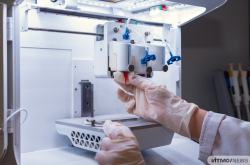Complex fractures — comminuted fractures, for instance (when the bone is split into several parts), are hard to heal by orthopedic means. To restore the limb's function, it is necessary to replace parts of the bone, but with what? A donor bone can bring in viruses or be rejected by the body. The use of metal implants call for a secondary intervention to remove them. Thus, polymer implants can become a great alternative: they are totally bio-compatible and gradually dissolve in the organism, being replaced by bone tissue in three to five years. The idea has already been around for some time: the first papers on the subjects were written around half a century ago. Yet, the problem is that polymers are easily infected by spores of microorganisms, bacteria and fungi, which is a significant drawback.
A polymer material is composed of molecules. Their chaotic arrangement leaves "pores" - they can take up to 10% of the polymer's volume, and can contain pathogenic microorganisms. This can result in dangerous infections, inflammations, as well as rejection of adjacent tissues.
"Introduction of a polymer inside the organism can lead to tissue rejection not because of the polymer itself, but because it brings in living organisms. Metal instruments can be disinfected by putting them in boiling water or an antiseptic solution, but you can't do that with plastic ones. This is why plastic syringes are single-use, for instance", shares Professor Igor Denisuk.
 ITMO University. Igor Denisuk
ITMO University. Igor Denisuk
So, what can be used to fill the pores? There are two possible solutions. The first is to stiffen the molecular arrangement so as to minimize the free space's volume. One of the ways to it is injecting nanoparticles into the polymer. The second option is to inject some antibacterial compound with prolonged effective duration that is compatible with live tissues. Noble metal particles are amongst the best choices here.
"Silver's antibacterial effect is based on its atoms being constantly desorbed from its surface as ions. These ions interact with the microorganisms' membranes, blocking DNA synthesis and thus stopping reproduction. Gold has a similar effect, though we still don't know the mechanism behind it. There are still few research articles on using nanoparticles in medical polymers. All the scientific results are made experimentally, but it is some fundamental principles that we need", comments Maria Fokina, associate professor of the Department of IT in the Fuel and Energy Industry.
Thus, nanomodified polymer implants can eliminate all the microorganisms that it brought into the human body, and ensure a quick osseous fusion. During the fusion, the bone will gradually grow through the implant.
The antibacterial effects of silver and gold particles, as well as antibacterial and antifungal effect of oxide nanoparticles, zinc and silicon compounds are the result of the particles' reaction with organic acids. This leads to release of bioactive soluble metal. Oxide nanoparticles also have a biocidal effect on pathogenic microorganisms: fungi, staphylococci strains, including stains that induce fungal infections resilient to traditional treatment methods.
 ITMO University. Maya Uspenskaya
ITMO University. Maya Uspenskaya
The other application field of nanomodified composites has to do with creating effective permanent dressings for treating severe burns and wounds. For these purposes, hydrogel and lyophilic nanomodified films can be used. They cover large areas and protect the organism from pathogens as they contain silver nanoparticles and bentonit, which speeds up the healing process. What is more, in this case the healing process goes over the whole wound or burn, not just its borders. In a sense, it is like second skin.
The use of nanomodified polymer technologies in medicine is sure promising, but is yet to be thoroughly researched, underlines Professor Igor Denisuk. For instance, it calls for research on the nanoparticles' toxicity, which is an important factor in treating humans. Then, the new methods are to pass testing and clinical trials.
"There is no compound with antibacterial properties that would not affect tissues. If an organism is sick, we have to use medications so as to cure the disease. The side-effects are inevitable, but they can and should be minimized. That is why we have to define which nanoparticles, biocompatible polymer matrixes and methods to using them work effectively and do not harm the human body", concludes the professor.





